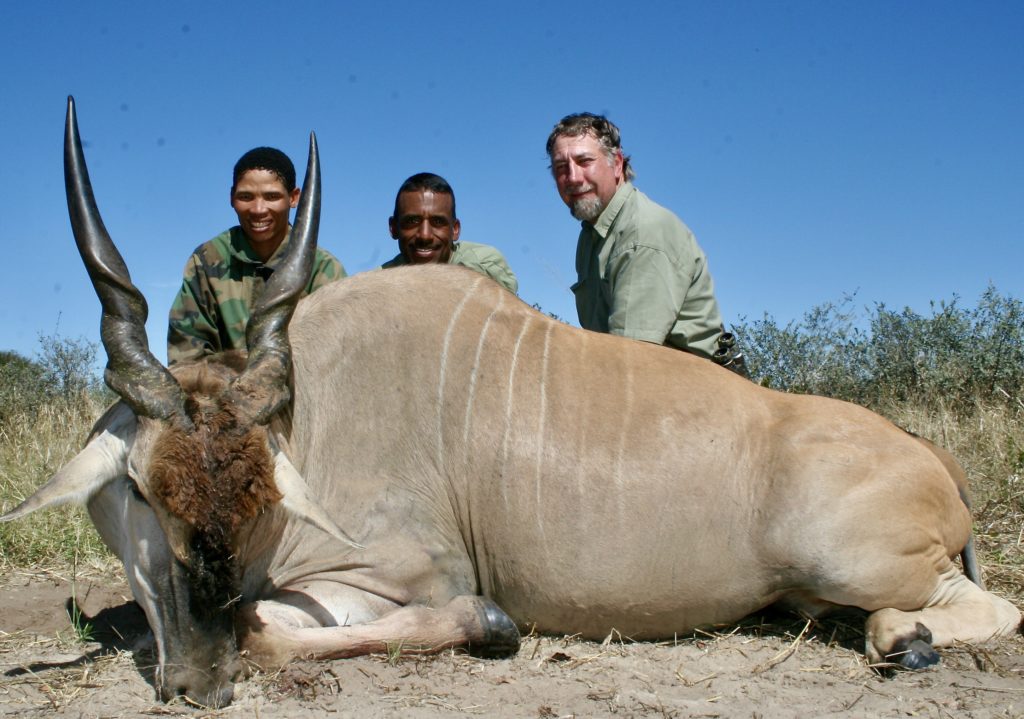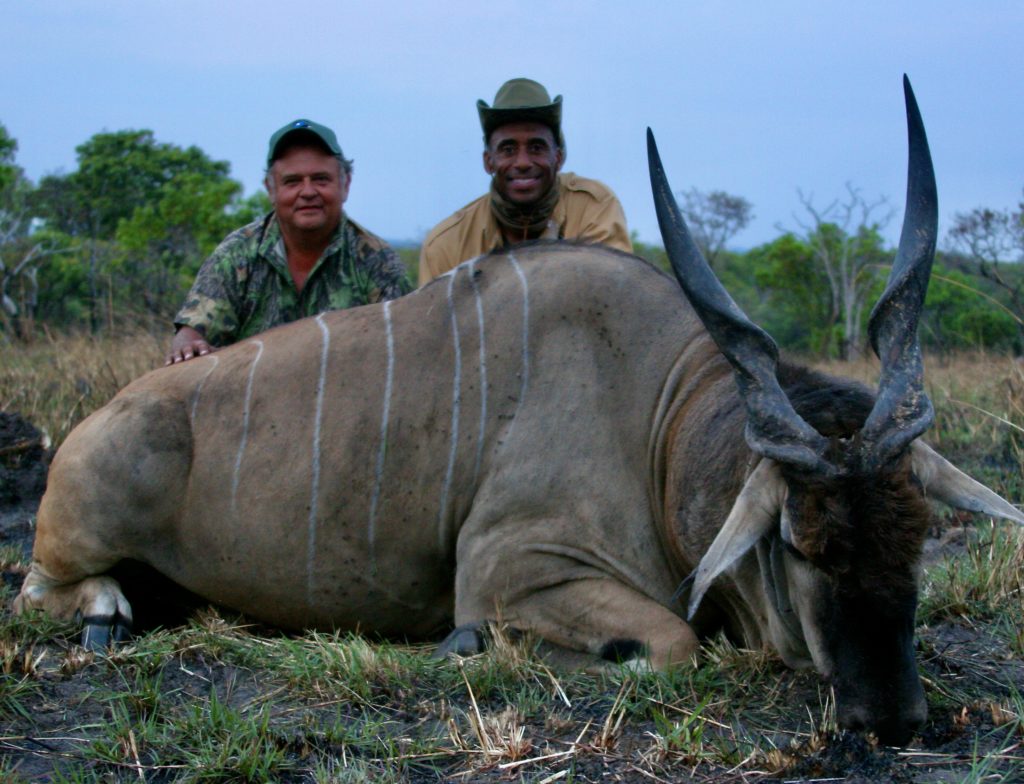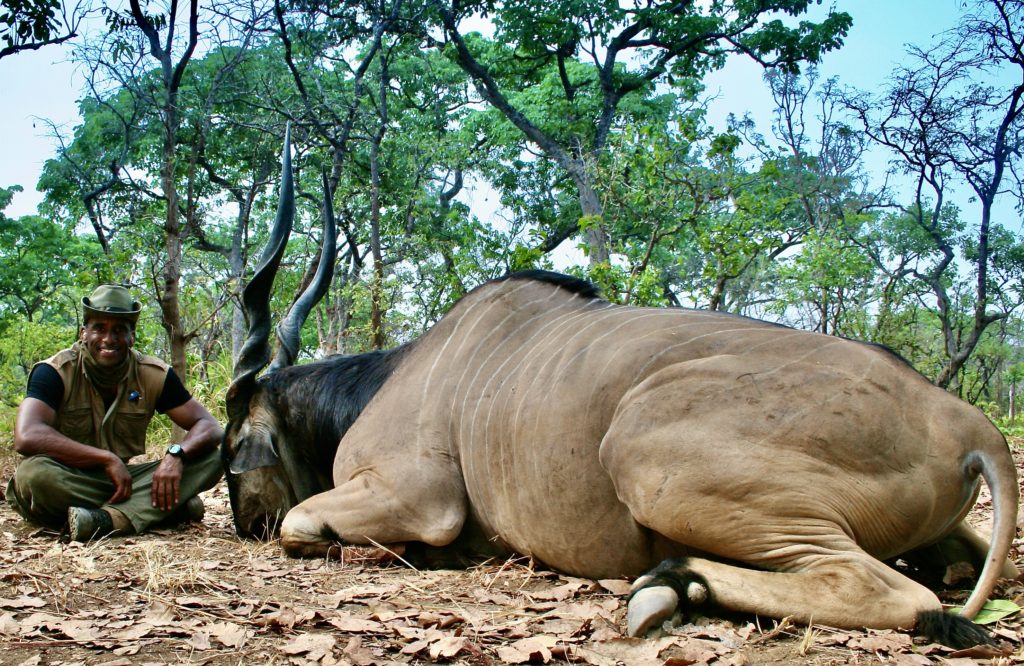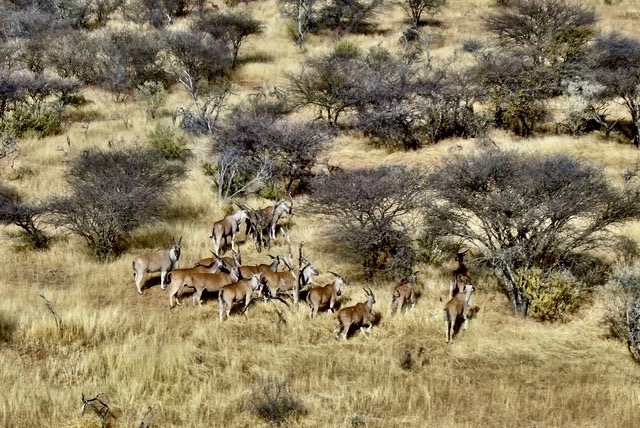Honoring Elands
Bwana Moja’s Eland Slam Spans His Extensive Hunting Career in Africa
Livingstones in The Kalahari, Pattersons in Tanzania, Capes in Limpopo and Lord Derby Elands in Central African Republic Gain In Popularity Among Hunters and Conservationists.
Originally published in November-December 2022 issue of SAFARI Magazine.
By Marc “Bwana Moja” Watts
My love affair with Africa has spilled well into its third decade. Certainly much more adventure awaits with my top three preferred species widely distributed throughout the continent, which are Cape buffalo, the Nile crocodile and eland. I’ve documented quite heavily why buffalo and crocodile are my standouts. Today I want to talk about the eland, the undisputed heavyweight champion of African plains game.
He gets the nod because Mr. Eland consistently offers a premium fair chase. This animal will make you earn it. You might catch him napping once, but don’t count on it twice. Shoot too high and you’ll only wound it. You’ll have the makings of a very long day.
On my first African safari, I passed on one. I was not confident in the gun I was using, nor in the ability of a 7mm Rem. Mag. to stop such a big antelope. My, how the context and narrative have changed in 25 years. Since that introductory safari, I’ve taken them with a .270 Win., .300 Win. Mag., .338 Win. Mag., .375 H&H and .470 Nitro Express. No longer lacking confidence with any rifle, I know the eland’s weaknesses and ideal shot placement regardless of angle. Yet they’ve earned my respect, for superior toughness, elusiveness and sensory perception.
I’ve seen them jump 8-foot fencing, stampede for three minutes in full sprint and bolt at the sound of the Land Cruiser they’ve detected from at least a mile away. The biggest of eland bulls on average are heavier than some Cape buffalo bulls.
The (original) common eland, also called Cape eland, is the second largest of the spiral-horned family, topped by its much bigger brother, the Central African giant eland. People should stop saying they “shot a big eland.” That’s like calling a tool a pointed ice pick. It goes without saying.
An eland’s size works to its advantage. Bigger eyes, ears and nose, and it stands tall, too. His detection capabilities are superior. In large herds, sometimes 200 at a time, that means 400 eyes and ears, with numerous noses to serve as sentry devices, long before you are even close to them.
It was only after I mastered hunting the common eland that I even dared going after the giant eland in Central African Republic. I was fortunate enough to take the still-standing No. 6 SCI giant eland some years ago. Ranging in hues from sand-colored to light chestnut, the eland stands out in many ways. The male version is the one plains game animal that looks like it spends time in Gold’s Gym.
Many of the Africa explorers in the 1700s all wanted a piece of it. Give credit to the earliest Dutch settlers arriving in the Cape of South Africa for naming the animal. It’s the Dutch word for elk. Scientist Peter Pallas is credited with giving us the first biological description of the eland in 1766, documented as the Cape eland. After that, every hunter who noticed a new wrinkle took it upon himself to declare a new subspecies.
In 1864 came the Livingstone eland, named after the Scottish explorer David Livingstone. Zoologist Philip Sclater designated this a subspecies after noticing differences from the standard Cape eland. The Livingstone version had torso stripes and other unique markings.
Lieutenant Colonel J.H. Patterson, of maneaters of Tsavo fame, has an eland subspecies named after him, too. In 1906, the naturalist named Richard Lydekker noticed an eland that Patterson had shot in Kenya. It was darker with distinctive hide characteristics and body markings. Lydekker declared it the next new subspecies, the Patterson eland. Today the Patterson subspecies is synonymous with East African eland.
The Zulu word for eland is “mpofu.” That will generate much social capital for you around a campfire and with the trackers. In Swahili, it’s just “pofu,” which means “the light-skinned or golden-skinned one.”
Then there is the Lord Derby eland, which is an entirely different species. It’s named after the 13th Earl of Derby, Edward Smith-Stanley. Explorer Joseph Burke captured a western African giant eland and transported it back to an enclosed park at Knowsley Hall, an estate near Liverpool where the Earls of Derby once lived. Not knowing what to call this living specimen, and becoming quite fond of it, Burke named it for the former residents, who are also called lords. John Edward Gray in 1847 was credited with writing the scientific description of the Lord Derbys. This etymology prompted me to brand a hunt for the Lord Derby, as “The Royal Showdown,” which was also the title of a book I wrote about my quest for the giant eland in 2008.
With the premium that safari hunters place on one perfect shot, the rewards of hunting eland are now widely sought after. It is no longer the forgotten one, it’s the preferred one. From South Africa to Cameroon, the eland in all its royalty, coloring, sizes and challenges is now a big-ticket draw to Africa.

LIVINGSTONE ELAND IN THE KALAHARI
Setting out in Botswana with professional hunter Johan Calitz and Bushman tracker Kamara Xhatshau, the objective of the day was clear. Kamara had scouted the concession for an outstanding specimen of a Livingstone eland prior to my arrival. The ideal trophy is a bull with a clump of hair between the ears, horns and eyes extending down the forehead, which is simply called the tuft, sometimes mop or rug.
Extremely old eland bulls, start to lose mass and length in their horns. They get “broomed off.” The shorter the horns comes the likelihood of a heftier tuft. In many cases, the extremely older bulls, however, will also suffer hair loss.
Superior horns extend the tape 38-44 inches around the spiral ridge. A handful of Livingstones have gone into the 45 to 46-inch neighborhood. Find a bull with this such extension, and he’ll likely carry the companion piece, the bushy tuft, making it the full package. Without the tuft, but carrying lengthy horns, it’s termed a “baldhead” still in its younger years. Be prepared to catch some flack if you post a young baldhead on social media. Critics will chastise you for not shooting a “proper” eland.
In 30 minutes of slow tracking, we’d caught up to the herd. We moved slowly because in this expansive patch of the Kalahari, there’s not a lot of vegetation to hide behind. Slow walking because you want to minimize the chance for an eland to detect movement. It was a deliberate stalk, one bush to the next, before finally getting into range.
The herd of 50 elands was feeding in a grassland 175 yards away with nothing in between us. So now was the time to shoot. If they scampered off, we’d simply relocate them and stalk back into range.
In my earlier days of hunting Africa, I could not distinguish eland cows from the bulls. But by now, experience had taught me how to tell the difference. All elands have horns, but bulls have larger necks, manes and heavier bodies. The thicker male horns typically branch into a V and are less parallel. Bulls have an expansive pendulous dewlap compared to a petite dewlap of a cow. It took me all of five seconds to spot the herd bull.
There were two lesser bulls as well, with 47 cows in this herd. Kamara had done his homework. A dozen of the cows had longer horns than my targeted animal, but as is often the case, their horns were spindly with slight spiral ridges, and cows look like runts compared to the muscular herd bull that also carries a darker coat.
Kamara stayed crouched behind the Hoodia gordonii, or Kalahari cactus plant. The Hoodia is a cactus that grows upward in bunches of succulent tubular protrusions. It’s a staple of the Bushman diet. At maximum height it grows to about 30 inches. So as Calitz and I stood up, we were exposed.
A cow serving as a lookout barked when she spotted us, as Caltz planted my shooting sticks into the ground. I travel throughout Africa with these sticks. Although just a tripod of connected poles, they’re as solid to me as a concrete bench rest.
In an organized fashion, in bunches of about 10 at a time, they dashed off. Calmly I rested my Jarrett-built .375 H&H in the cradle of the shooting sticks and took aim. The herd bull was third from the back, galloping away to my right, with a body-length of space in front of him as he struggled to maintain pace with the bulk of the herd. I placed the shot properly and flattened him in mid-stride. He bulldozed into the ground creating a cloud of red dust.

PATTERSON IN TANZANIA
Hunting in southwest Tanzania one year, I finally learned to stop believing everything I was reading about safari animals. I realized I needed to observe and verify for myself. Heading back to camp one late afternoon with PH Gerard Miller behind the steering wheel, he stopped the vehicle in the middle of the road.
“Bwana, get ready,” he said. “There’s often a large eland herd in the savannah up ahead on the left side of the road at this time of the day.”
I thought elands were non-territorial. “I read that they move around a lot and don’t often graze in the same place,” I said.
“Bwana, believe what you experience, not what you read in magazines,” Miller responded.
I hopped into the high seat and Gerard became the front seat passenger as his lead tracker, Iddi, took the steering wheel.
Our plan was in full motion. We drove a half mile down the road. I tapped twice on the top of the cab. Miller was right. From my vantage point standing up in the back, I spotted the herd grazing in a grassy plain exactly where my PH said they’d be. I learned my lesson that day. With the vehicle almost parallel to the herd, Miller and I exited the Land Rover on the right side as it was still moving. We went around the back and crouched under a miombo tree just off the left side of the road.
The vehicle continued slowly past the herd, with Iddi driving and the game scout in back. We were attempting to deceive the herd that the vehicle’s occupants had no interest in them.
I was in awe. Just 60 yards away was a herd of 70 Patterson, also called East African, elands taking in a late afternoon lunch. Miller gave me that look; a wide-eyed, head tilted stare that said without words: “Now do you believe me?” I was bushwhacked, and I deserved it. Now the real challenge. I needed to not mess up the shot, given that he placed me in such close proximity.
We were kneeling in single file. Gerard was behind me. All our eyes were focused on the herd bull. He was standing left, almost completely shielded by a calf in front of him. The presentation offered me a small window to sneak the bullet through.
I got as low as I could in the kneeling position and fired the gun. The bullet traveled below the calf’s chin and into the left shoulder of the eland bull. He expired where he was standing. It was my first Patterson eland.
On this day with Miller, I learned that elands are territorial and predictable. They will repeatedly visit a food source they find to their liking. This runs contrary to what has been written on the record before. I would learn later in my hunting career that elands are attracted to natural salt licks, which leave footprints for hunters to pursue them.
Here’s another bone of contention also, I’ll lodge with the literature. People who’ve written about elands would have you believe all elands in Tanzania are of the Patterson/East African variety. I’ve seen numerous elands in the lower Selous Game Reserve and in Western Tanzania that are Livingstone not Patterson. This observation is backed by many Tanzania PH’s.
“Moja, I’ve hunted substantially in the lower half of Tanzania to realize significant numbers of Livingstone eland roam Tanzania,” said Miller, who has hunted Tanzania for four decades.
The range of Livingstone elands now extends north from Zambia into Western Tanzania, and north from Mozambique into South Tanzania. I have video footage of the herds, documenting the subtle yet distinctive body markings to verify the Livingstone’s existence in Tanzania.
Northern Tanzania, Masailand, Maswa and the Serengeti areas extending into Kenya mark the home turf of only the Patterson eland. Of course, the Patterson is thriving in numerous other geographic parts of Tanzania as well.
My Patterson eland was smaller in body size compared to the Livingstone eland. Yet it had a much darker coat, tuft hair growth down to the nose and more pronounced torso stripes. Most good trophies also bear a blackish-brown hair ridge from the top of the neck to rump.
According to record book minimums and entries, the Livingstone eland has the longest horn length, followed by the Cape and then the Patterson.

CAPE ELAND IN LIMPOPO PROVINCE
My flight had been canceled, and British Airways lost my luggage. My original final destination was actually the Zambeze Delta in Mozambique, but without all my gear I was in a holding pattern. I turned the wait time into an opportunity to go hunting within distance of the airport. I decided to visit my original PH Marius Kotze in Hoedspruit at Rhinoland Safaris near Kruger National Park.
Fortunately, my gun case with bullets did arrive. At O. R. Tambo International Airport, it only took a warm smile, some autographs, pictures and polite gestures with the South African Police Service to process new paperwork, and I was good to go.
The next day, Kotze and I set out on eland tracks, and in an hour, we’d caught up to the herd. There were 40 of them with two shooter bulls on the far right, separated from the herd grazing in the savannah, mostly bunched up to the left.
We were concealed 125 yards away by the native grasses and bush. To get in shooting range, we still had 80 yards ahead of us, where I could take cover behind a knob thorn tree. Kotze bent down and told me to stalk solo the rest of the way.
There were the final 10 steps to the tree. As I got there, the herd spooked and started running away to my left. I calmly stepped out to the left side of the tree and lined up freehand on the very back animal in the herd, the better of the two bulls. But he suddenly put it in reverse and ran back the other way.
I dashed to my right on the other side of the tree and dropped the eland bull with a clean second shot quartering away to the right shoulder. The first shot? It missed completely, too far in front. But the second connected, and the animal took a hard dive into the dirt. We finished the evening with photos as the sun set behind us.
The eland slam is as impressive as any slam you can dial-up in plains game hunting. The additional benefits are the diverging cultures you’ll experience on your way to the slam. Mine took me through South Africa, Botswana and Tanzania. But, of course, it’s not a grand slam without the fourth member of the quartet.

GIANT ELAND OF CENTRAL AFRICAN REPUBLIC
I was hunting with PH Andre Roux in Central African Republic. It was Day 13 on a 14-day safari, and I hit my bar. If you’ve ever watched Olympic gymnastics, you know what I’m talking about. The competitor performs a tremendous routine but flubs the landing. There’s that look on their face. They know there’s still room for improvement. Well on this day, just this one time in C.A.R., I stuck my landing. This time, it all came together.
After four hours of chasing the same herd, we finally maneuvered in front of it. Anticipating the herd’s arrival, I reached into my cargo pant pocket to refer to my DOPE card (Data Observed on Previous Engagements). I wanted to make sure I aimed low enough to strike the heart with a frontal shot and could sneak the bullet past the swaying dewlap, which conceivably could alter the shot’s impact.
I had to time the trigger properly as the dewlap swung back and forth, opening the window to a straight-on shot. In what amounted to a strategic ambush, from 90 yards away I fired on the largest antelope by far that I have ever seen. The animal was dispatched with a single frontal shot. It was astonishingly giant eland.
A zoologist who reviewed the photographs, video and all the green measurements said it was the largest most complete mature African antelope he had ever seen in the world. He wrote this scorecard:
- Mane: Thick, black and full
- Quality: Superior
- Tuft: Thick, bushy and full
- Quality: Excellent
- Animal’s age: Estimated 20 yrs. old
- Quality: Superior
- Body Weight: Estimated 2100 lbs.
- Quality: Superior
- Horn Length: 56 x 56 inches
- Quality: Superior
This accomplishment again proved Wikipedia and all the journals wrong. They claim a giant eland has between 12-15 torso side stripes. The one I took has 16. No one I am aware of had ever seen a 16th side stripe because they’d never seen any eland with a body this long, which prompted growth of the additional stripe.
We say that you can’t spell science without SCI. There’s truth to that because we’re the ones on the ground, embedded with wildlife and people. We are simply in better touch with animals. Our ground forces rely on trail cameras, and we lay hands on various species, allowing us to examine wildlife in depth.
We interact closer to animals and derive knowledge from extended observation. Our science benefits from better collection methods, not purely based on drone photography, helicopter surveys, zoom lenses and, might I add, fear.
IN HONOR OF ELAND
With the findings documented in this journal, maybe this article will be archived and deep-linked so that people seeking information in 2022, ’23 and beyond about common and giant elands can derive a more accurate description on the anatomy, characteristics and geographical locations of these two species. Animals migrate, crossing borders and the genetic variants resulting from adaptation can generate distinctive traits, endemic to specific habitat.
Explorers, adventurers and hunters rely on what’s written in the best interests of furthering conservation. You want to enter the field with the most reliable information to even improve on the canvas that educated you and make the best selective decision before you pull the trigger, especially on the most king-sized animals of the plains game family.

Prime Choice
Certainly, it happens but you will hear and see very few reports of mature eland bulls falling victim to lions. You’ll hear of far more zebras, wildebeests and Cape buffaloes becoming prey. Elands are aggressive and will stab predators with their horns. Their massive dewlaps serve as a shield of neck padding. It’s doable for a lion, but it would take a big mouth and the right grip to bite down to the windpipe through an eland bull’s swollen neck and dewlap tissue.
Elands will communicate impending danger to the herd by head gestures, pacing in different directions and making peculiar noises. Their skittish behavior has helped them survive over the thousands of years. In some instances when feeling threatened, a herd bull will vacate its herd, apparently achieving better safety individually while perhaps also hoping to divert the predator from the larger group.
Eland venison is so well regarded as prime table fare that in some parts of the world, such as the Askania-Nova Zoo, known as the Ukrainian Serengeti, farmers raise elands domestically. (According to the latest reports, the zoo has survived the recent Russia invasion.) They’ve been introduced at Texas ranches. They’re also highly prized for their protein-rich milk and hides which are processed into leather. Eland ranches, however, must be expansive, because if pressured toward the outer boundaries, these animals will simply jump over most barriers.
Nothing, however, compares to the indigenous species living in Africa. In its home element the eland thrives as an herbivore feasting on the vast offering of native grasses and leaves which makes it a hybrid feeder that will browse and graze. You can take an eland out of Africa, but I believe it’s impossible to reproduce its rich habitat.—MW
Bwana Moja, also known as Marc Watts, is an international hunter and journalist. He is a life member of SCI, author of two books and is featured in numerous hunting videos. Bwana Moja was the name given to him in Zambia by a PH and his trackers. It’s Swahili for “Mr. One Shot.”

